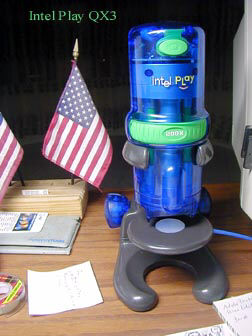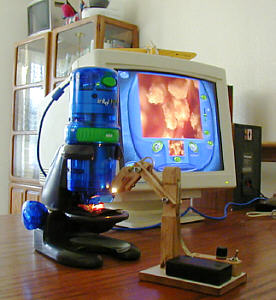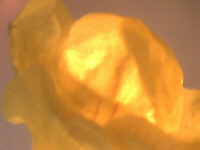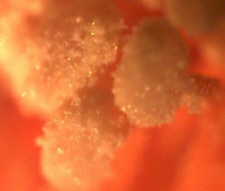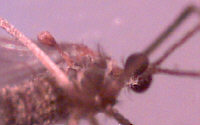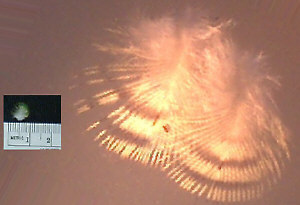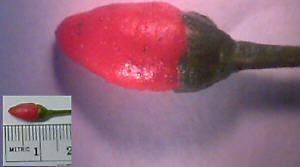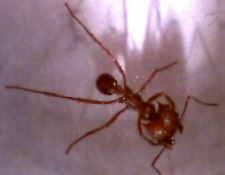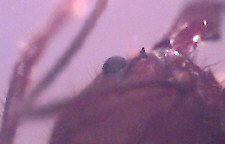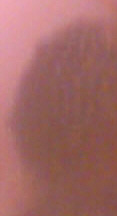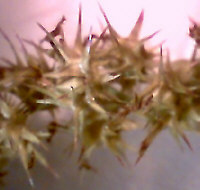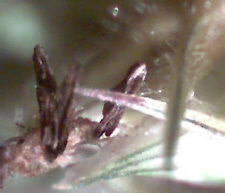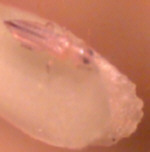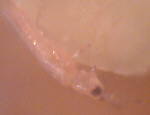The First impressions by |
|
Intel, the computer chip makers, and Mattel, the toy designer, have in partnership designed a very educational toy, to teach optics, imaging and computers. This is a high technology enterprise, and it takes a fairly good computer to use it. Windows 98 with support of the USB port is essential, a fast processor surely helps.
The magnifications are 10X, 60X and 200X; there is no eyepiece, all the imaging is on the computer screen, and the power for the whole thing comes from the USB port. No batteries to buy!!
A green LED is in the top on the circuit board, and it lights up, as soon as it has a connection to the computer, so one knows the connection is OK.
The software comes on a CD-ROM, and it really is outstanding in its functionality, it is very easy to install, and looks very nice, with a lot of sound, yes, this is not a quiet microscope. Even the help is sound only. The only thing I miss is a minimizing button, so I can look elsewhere for pictures etc., I always have to shut the program down, there is supposed to be one in the timelapse mode, I have not really tried that.
It is very easy to take snapshots of the image in the main viewing screen, or make movies and take timelapse photomicrographs in intervals of 1 sec to 1 hour.
The objective turret rotates very positively and smoothly and has a stainless steel ball to stop it precisely. The working distance is quite good at about 25 - 28 mm. The objectives are protected by a clear polycarbonate cover, that is mounted with screws, this cover is easily scratched, but replaceable. It is possible to obtain spares from Mattel, and it's probably a good idea to have some on hand along with extra light bulbs.
The microscope is designed with 2 light sources, one for reflected and one for transmitted light.
The reflected light source is under the protective lens cover; when the body is lifted off the stand, in order to use the microscope in a portable manner (to the length of the cable) the light goes with it. The stand with its stage has electrical contacts to control the transmitted lightsource. All the controls are on screen, but in the portable mode there is a button on the top that can be used to take snapshots or movies and timelapse, if it is kept depressed. The big focusing knobs work smoothly, I never had any problems with them jerking.
| I made a small auxiliary lamp with a variable resistor incorporated, that helps a lot to get different light on the subjects. This can be seen in the picture of the whole setup (right). I get better colors with my aux. lamp, and it is of course much more flexible. I want to try laser light and fluorescent light in the future. |
|
Comments to the author Rudolf Baumueller welcomed.
The QX3 makers website is at http://www.intelplay.com.
Additional notes:
Images of the microscope
were taken on my Olympus D-450 zoom digital camera.
A minimum requirement of a 200 MHz Pentium processor with 32
MB Ram and a 800 X 600 pixel display with 16-bit color depth,
that are 65,536 colors is asked for by Intel, [but this would
be very minimal, and make the actual image coming from the
microscope very jumpy].
I have a 500 MHZ processor, 64 MB Ram and 32-bit color depth
with an 800 X 600 display. That works very well. I have not
tried to take any video as yet.
Editor's note: The makers stated magnifications 10X, 60X and 200X are based on the images being displayed on a 15 inch monitor; the primary magnifications of the QX3's objectives will be a lot less.
Editor's update Dec. 2004: The updated model, the QX5 made by Digital Blue, is reviewed in the Dec. 2004 issue.
Image
gallery
(Editor: Resized
and cropped from the images sent ca. 480x360 pixels).
|
|
|
|
|
